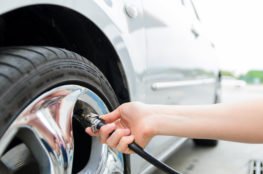
Americans have long had a love affair with the automobile. That relationship goes back to the early days of the magnificent horseless carriage, spanning multiple generations and many incarnations of cars, trucks, and other modes of mechanized transportation. It has survived depression, world wars, and oil shocks that brought gasoline deprivation, rationing, and exhortations to conserve fuel. Today, cars and trucks are as important to our lives as they have ever been, providing freedom, mobility, and a greater sense of security for most people in the United States. Despite that abiding love affair, many millions of Americans remain woefully –and sometimes dangerously – unaware of the importance of tire maintenance for their vehicles.
A Problem of Epic Proportions
America’s cars and trucks see a great deal of action each year. The amount of driving done by Americans has been rising with each passing decade, making it more important than ever that Americans learn to properly maintain their tires.
Sadly, however, the numbers indicate that many Americans still fail to address this basic maintenance need. Reports from the National Highway Traffic Safety Administration (NHTSA) suggest that tires are at least partially responsible for some 11,000 traffic crashes each year. Worse, their numbers indicate that nearly 200 people die in those accidents. That’s roughly 200 deaths that might be preventable just by paying more attention to basic tire care.
There is a financial cost to all of this as well. According to the Car Care Council, a lack of overall vehicle maintenance is directly responsible for many thousands of automobile accidents each and every year. Together, those accidents result in damages that are in excess of $2 billion annually. Given the NHTSA estimates on tire-related accidents, it is clear that a substantial portion of those damages could be prevented with adequate tire maintenance.
Even Underinflated Tires are a Problem
Tire maintenance may bring to mind thoughts of tread wear and other damage, but it goes far beyond those concerns. Even seemingly minor issues such as tire inflation can have an impact on the risk to you and your passengers. For example, the NHTSA estimates that around a quarter of a million accidents each year involve cars and trucks with low tire pressure. Low pressure affects everything from traction and braking to how your vehicle handles on the road.
Recent studies by that agency reveal that there may be a direct relation between underinflated tires and the risk of accidents. By the NHTSA’s estimate, if your car is deflated to less than 75% of its operational capacity, it is three times as likely to be in a car crash as a vehicle with tires that are fully inflated.
What Drivers Don’t Know
The real problem seems to be in the area of driver knowledge. Various studies have revealed that America’s drivers really don’t seem to know all that much about how to properly care for their tires. Just consider the alarming fact that surveys indicate that 85% of American drivers claim to not even know how to inflate their tires, or admit that they are not sure what the proper pressure should be! Here are some other important things to consider:
- The total amount of time that is required to check your tires’ air pressure amounts to no more than ten seconds a day, or five minutes each month.
- That five minutes could help you save somewhere in the neighborhood of 12 cents on each gallon of fuel since proper inflation of your vehicle tires is one of the best ways to enhance the fuel efficiency of your car or truck.
- AAA reportedly assists more than a million motorists each year who have to call for help due to issues having to do with their tires.
Caring For Your Tires
Given that most Americans are unsure about how to maintain their tires, chances are that you might have a few questions yourself. The good news is that there are some fairly standard things to look for, and easy maintenance steps to take to ensure that your tires remain functional, safe, and legally eligible for use on the road.
- Align the Wheels. You should have your wheel alignment checked by professionals each year, or any time that you are worried that the alignment may be off. For example, if you find your car pulling to one side, there is a good chance that your wheels are misaligned.
- Tire Rotation. Your owner’s manual will offer guidance about the recommended schedule for rotations, and you should follow those instructions. Regular rotations can protect your tires from irregular wear and improve their longevity.
- Monitor wear. Keep an eye out for tread wear, since any damage to your treads can cause hydroplaning and other issues. One quick test involves using a penny to measure the wear. Simply take a penny and insert it into the tire tread. If the tires are worn to the point where you can see any part of President Lincoln’s head, you should start thinking about getting new tires.
- Inflate your tires. It is important to use a tire pressure gauge to ensure that your tires are properly inflated. Inflation is important for proper road grip, handling, and braking.
In Texas, It’s the Law!
If you reside in the state of Texas, then you may already know that proper tire maintenance is a requirement if your vehicle is to pass the state’s inspection requirements. Once a year, you have to undergo a visual inspection of your tires. Tread is measured, and proper inflation is checked. Your tires could be rejected if there is a visible cord, or cracks and snags larger than an inch in length and depth. Other causes for inspection rejection include structural damage and a number of other problem signs. You should familiarize yourself with the inspection requirements prior to your appointment.
The importance of proper tire maintenance simply cannot be overstated. Treadwear, misaligned wheels, and improper inflation are just a few of the tire-related problems that can result in accidents, injuries, and even death. The good news is that taking care of your tires is an eminently attainable goal that can be met with little time and effort.
CONTACT HERRMAN & HERRMAN IF YOU HAVE BEEN INJURED IN ANY OF THE FOLLOWING TYPES OF ACCIDENTS:
We can help you if you have been harmed by the following:
- Car accidents – Our lawyers have extensive experience handling car accident cases. We will work to identify the party or parties at fault for the crash and build a case to demonstrate persuasively how the parties caused the accident and your injuries. We will seek fair and full compensation through a negotiated settlement or at trial if necessary.
- Truck accidents – Thousands of large commercial trucks travel the roads of Texas every single day. Unfortunately, careless truck drivers and trucking companies disregarding safety put innocent people at risk of serious injuries. If you’ve been injured in a truck accident, let our experienced Texas personal injury lawyers stand up to the trucking companies and insurers on your behalf.
- Motorcycle accidents – Motorcycle riders often suffer grievous injuries in crashes caused by other motorists. Too many motorcycle accidents in Corpus Christi are caused by careless drivers who don’t look for motorcycle riders or violate their right of way. Our personal injury lawyers will work to cut through the bias and stigma against motorcycle riders. Our goal is to seek the financial compensation that you’ll need to recover from a serious motorcycle accident and injuries such as bone fractures, road rash, or traumatic brain injury.
- Product liability – Product manufacturers have a legal obligation to make products that are safe for their intended uses and to warn consumers of any risks that may come with the product. When products have design or manufacturing defects or undisclosed dangers, the product manufacturer may be legally responsible for injuries suffered by consumers. Our attorneys can help you evaluate whether you have a valid product liability claim.
- Brain injury – Brain injuries can leave accident victims with disabilities that leave them unable to work or perform many tasks of daily living. Seeking compensation for a brain injury in an accident often proves incredibly complex. The brain injury survivor may seek compensation for anticipated future medical care and the medical care already provided. Our personal injury lawyers can help you through the difficult recovery process following a brain injury and will fight to make sure you have the resources you need.
- Spinal injury – Spinal cord injuries could cost millions of dollars of care over the course of the victim’s lifetime, especially when those injuries result in partial or complete paralysis, such as paraplegia or quadriplegia. If you or your loved one has suffered a spinal cord injury, you deserve compassionate legal representation. Our attorney can help you determine whether you may be entitled to claim compensation for your injury and expenses related to living with the disability, such as making a home more accessible.
- Wrongful death – If you have lost a loved one due to the negligent or reckless actions of another party, your family deserves to seek accountability and compensation from those at fault for the wrongful death. Our caring and dedicated attorneys can help guide you and your family through this difficult and painful time and seek justice for your loved one.









